We’ve all been there – staring at our beautiful garden beds while cringing at the thought of expensive fencing costs. The good news? You don’t need to expensive to create attractive boundaries that protect your plants and define your outdoor spaces.
Budget-friendly garden fencing answers can be just as effective and visually appealing as their pricier counterparts. From repurposed materials you might already have lying around to clever DIY projects that cost under $50, there are countless ways to fence your garden without emptying your wallet.
Whether you’re looking to keep pets out of your vegetable patch, create privacy around your flower beds, or simply add structure to your industry design, we’ll explore practical and affordable options that deliver real results. These creative fencing ideas prove that style and functionality don’t have to come with a hefty price tag.
Bamboo Fencing Solutions for Budget-Conscious Gardeners
Bamboo fencing offers one of the most cost-effective ways to create attractive garden boundaries. We’ve found that these natural answers typically cost 40-60% less than traditional wood fencing while providing excellent durability and visual appeal.
Natural Reed and Bamboo Panels
Ready-made bamboo panels provide instant fencing answers for gardeners seeking quick installation. These pre-constructed panels typically measure 6 feet wide by 4-8 feet tall and cost between $25-45 each at home improvement stores like Home Depot and Lowe’s.
Installation requires minimal tools since most panels come with built-in wire attachments or metal ties. We secure these panels to existing fence posts or wooden stakes using zip ties, wire, or small screws. The process takes approximately 15-20 minutes per panel.
Rolled bamboo fencing offers another budget-friendly option at $1-3 per linear foot. These flexible rolls adapt to curved garden beds, raised planters, or irregular spaces where rigid panels won’t fit. Garden centers typically stock rolls in 3-foot, 4-foot, and 6-foot heights.
Natural reed panels cost slightly less than bamboo at $20-35 per 6-foot section. Reed provides excellent privacy screening and creates attractive backdrops for flower gardens or vegetable plots. These panels work particularly well in cottage-style or naturalistic garden designs.
| Panel Type | Cost Per Section | Installation Time | Best Uses |
|---|---|---|---|
| Bamboo Panels | $25-45 | 15-20 minutes | Privacy screens, property lines |
| Rolled Bamboo | $1-3 per ft | 10-15 minutes | Curved areas, planters |
| Reed Panels | $20-35 | 15-20 minutes | Garden backdrops, screening |
DIY Bamboo Pole Installation
Individual bamboo poles create custom fencing designs while keeping costs under $30 for a 20-foot section. We purchase 8-foot bamboo poles for $3-6 each from garden centers or order bulk quantities online for additional savings.
Spacing poles 6-8 inches apart provides adequate privacy while minimizing material costs. We dig holes 18-24 inches deep using a post hole digger or shovel, then secure each pole with concrete or packed soil. This spacing uses approximately 15-20 poles per 10-foot section.
Horizontal bamboo rails connect vertical poles to create sturdy fence structures. We attach 1-inch diameter bamboo horizontally at the top, middle, and bottom using outdoor zip ties or galvanized wire. These rails cost an additional $2-4 per 10-foot section.
Creating gates becomes simple by leaving appropriate spacing between poles and adding hinges to bamboo frames. We construct basic gates using four bamboo poles connected in rectangle shapes, then attach them to fence posts with outdoor hinges costing $8-12 per set.
Bamboo treatment extends lifespan from 3-5 years to 8-10 years with proper preparation. We seal bamboo poles with clear outdoor wood stain or bamboo preservative costing $15-25 per gallon, which covers approximately 100 linear feet of fencing.
Pallet Wood Fencing Projects That Cost Almost Nothing

We’ve discovered that shipping pallets offer the ultimate budget solution for garden fencing, often costing nothing more than your time and effort. Building with these recycled materials delivers professional-looking results while keeping expenses near zero.
Repurposing Free Shipping Pallets
Free pallets provide an endless supply of quality wood for garden fencing projects. We find most shipping companies, furniture stores, and construction sites gladly give away pallets they no longer need. Hardware stores, grocery chains, and warehouse retailers frequently have surplus pallets available for pickup.
Choosing the right pallets ensures successful fencing projects. We recommend selecting heat-treated pallets marked with “HT” stamps rather than chemically treated ones marked “MB” for garden safety. Standard pallets measuring 48″ x 40″ contain enough wood planks to create 6-8 feet of vertical fencing when disassembled properly.
Disassembling pallets requires basic tools like a pry bar, hammer, and reciprocating saw. We start by removing nails carefully to preserve board integrity, then clean each plank thoroughly before installation. Sanding rough edges creates smoother surfaces while maintaining the rustic character that makes pallet fencing appealing.
Creative Pallet Fence Design Ideas
Vertical pallet fencing creates the most common and straightforward design approach. We position whole pallets upright between fence posts, securing them with exterior wood screws through the frame rails. This method provides immediate coverage while maintaining structural integrity across longer fence runs.
Horizontal pallet arrangements offer a modern farmhouse aesthetic that complements garden landscapes beautifully. We disassemble pallets completely, then attach individual planks horizontally between posts with 2-4 inch gaps for visual interest. This design requires more labor but delivers sophisticated results rivaling expensive cedar fencing.
Mixed height pallet gates add functional elements to basic fence designs. We create swing gates by mounting two pallets on heavy-duty hinges, adding barrel bolts or simple latches for security. These gates typically cost under $15 in hardware while providing convenient garden access points.
Decorative pallet screens serve dual purposes as plant supports and privacy barriers. We position pallets vertically to create backdrop walls for climbing plants like beans, cucumbers, or morning glories. These living fences combine functionality with natural beauty as vegetation fills gaps between slats throughout growing seasons.
Wire and Mesh Fencing Options Under $50
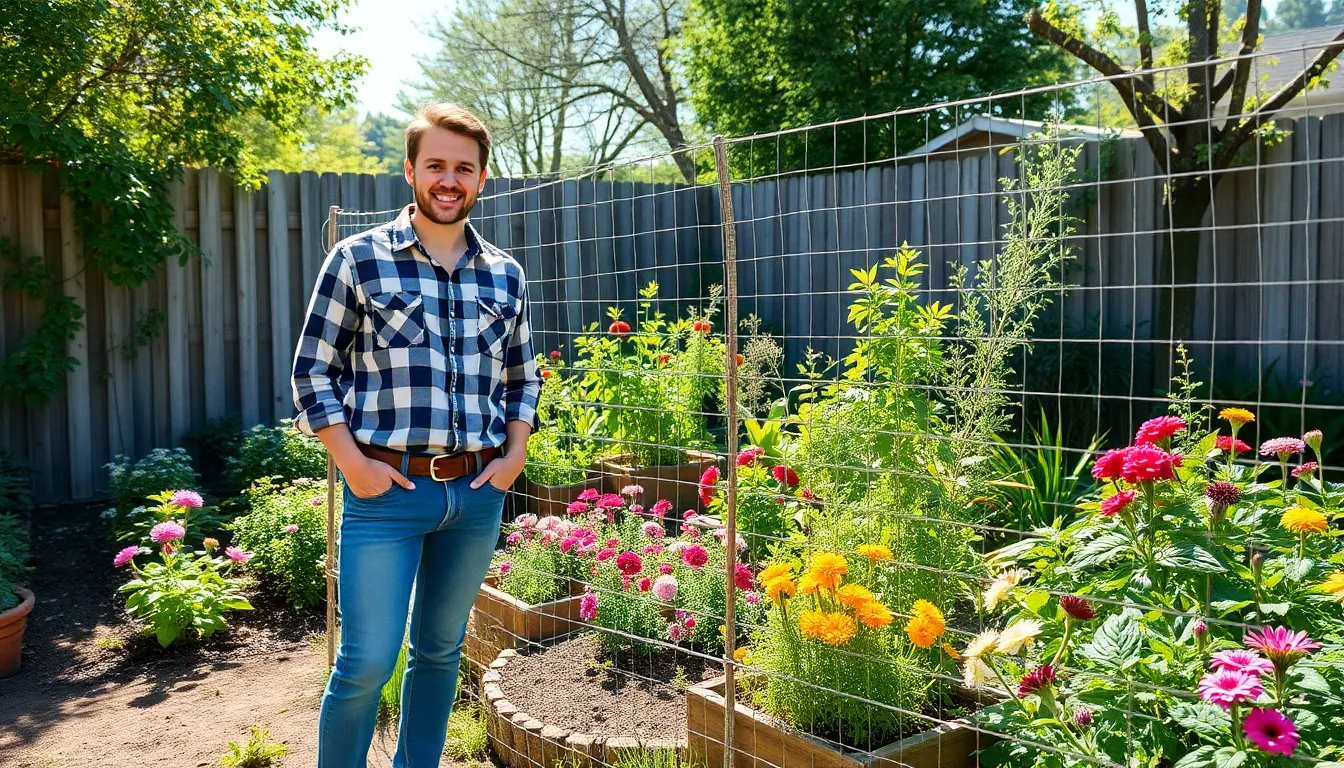
Wire and mesh fencing provides the most affordable protection for our gardens while maintaining excellent functionality. We can create complete fence systems for small garden areas with materials costing between $20 and $50 total.
Chicken Wire Garden Boundaries
Chicken wire stands out as our most economical fencing choice, widely available at hardware and garden stores nationwide. We typically spend around $16.44 per roll for standard black plastic net or mesh, with two rolls covering a 10 x 8 foot garden area effectively.
Lightweight construction makes chicken wire incredibly easy for us to install without professional help. We simply unroll the mesh, stretch it between wooden stakes or metal posts, and secure it using a basic staple gun. This material keeps small animals away from our plants while allowing essential sunlight and air circulation to reach our garden beds.
Installation requires minimal tools:
- Staple gun for securing mesh
- Level for proper alignment
- Hammer for driving stakes
- Basic measuring tape
We can construct simple gates using spare wood, hinges, and a latch, repurposing leftover mesh as gate panels. Total project costs rarely exceed $30 for smaller garden boundaries when we choose chicken wire as our primary material.
Welded Wire Mesh Installation
Welded wire mesh offers superior durability compared to standard chicken wire, making it our preferred choice for gardens requiring stronger protection. We find this option slightly more expensive but still budget friendly for complete fence projects under $50.
Installation follows the same basic process we use for chicken wire, though welded mesh provides enhanced structural integrity. We stretch the material between posts and secure it with staples or specialized clips designed for heavier gauge wire. Metal posts work particularly well with welded mesh due to the material’s increased weight and strength.
Key advantages of welded wire mesh:
- Stronger construction resists damage
- Better protection against larger pests
- Maintains shape over time
- Suitable for climbing plant support
We cut welded wire mesh to our desired dimensions and attach it securely to wooden or metal support posts. The installation process typically takes us 2-3 hours for a standard small garden perimeter, requiring only basic DIY skills and common household tools.
Natural Branch and Twig Fencing Techniques
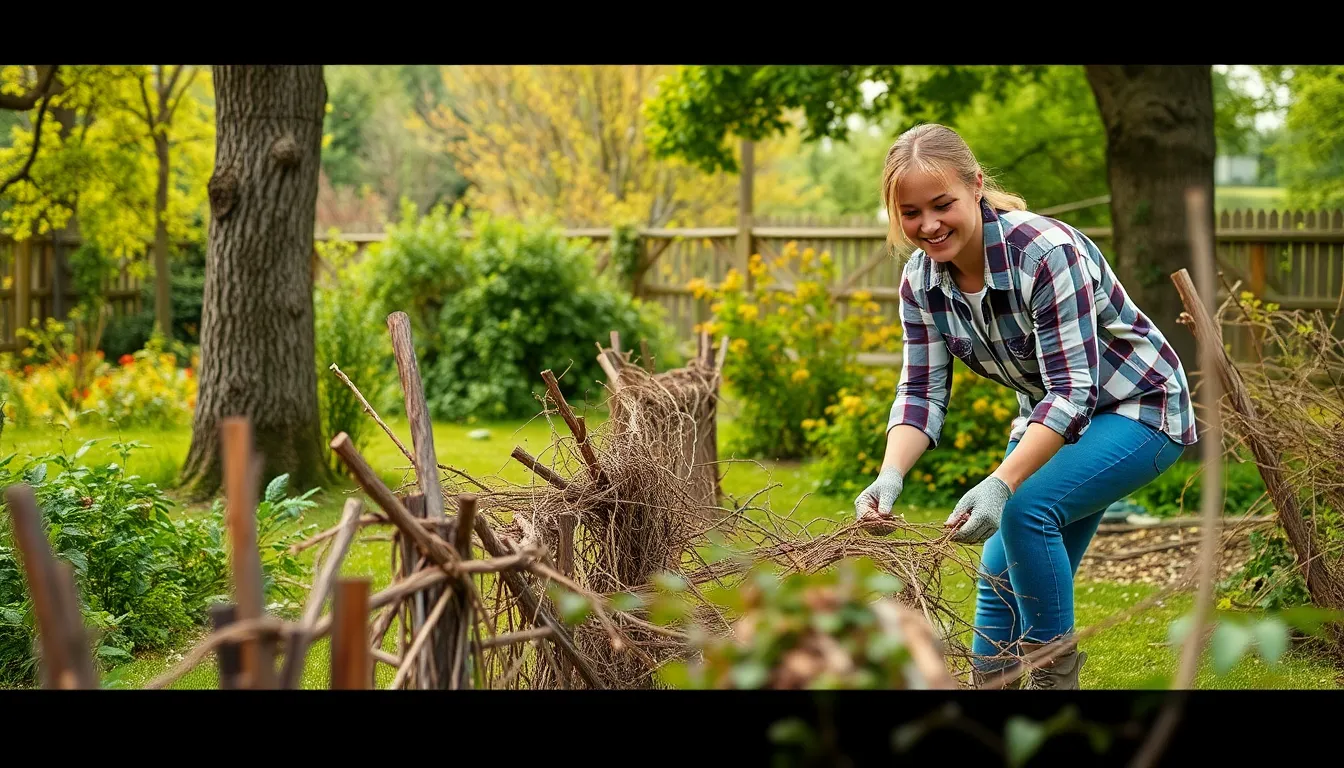
Natural branch and twig fencing offers an eco-friendly solution that costs practically nothing while creating charming garden boundaries. This rustic approach transforms fallen branches and collected materials into functional barriers that blend seamlessly with your industry.
Collecting Free Materials from Your Property
Fallen branches from storms or seasonal pruning provide excellent fencing materials without any cost. We can gather branches of varying sizes from our property, focusing on hardwood species like oak, maple, or birch that resist decay longer than softwoods.
Trimmed material from routine tree maintenance creates another valuable resource for natural fencing projects. Property owners often overlook these materials, but we can collect them immediately after pruning to ensure they’re fresh and pliable for weaving.
Wooden pallets discarded from deliveries offer sturdy base materials that we can disassemble and repurpose into fence posts or panels. Local businesses frequently give away used pallets, making this an excellent zero-cost option for creating fence frameworks.
Old fencing components from previous installations can be incorporated into new natural designs, reducing waste while cutting material costs. We can salvage usable posts, wire, or decorative elements and combine them with natural branches for hybrid fencing answers.
Weaving Techniques for Rustic Appeal
Twig and vine weaving creates attractive barriers by interlacing flexible branches between vertical posts in a basket-like pattern. We place larger branches as the foundation and weave smaller twigs horizontally, securing them with wire or natural twine at regular intervals.
Bamboo fencing using collected bamboo sticks provides lightweight construction that’s easy to install and naturally weather-resistant. These materials can be woven together or attached to posts using zip ties, creating clean lines that complement both modern and traditional garden designs.
Reed fencing involves weaving together collected reeds or tall grasses to form dense screens that effectively block small animals. We can harvest these materials from wetland areas on our property or from neighbors who want overgrown areas cleared.
Branch securing methods using wire or twine ensure our woven fences remain stable through weather changes and seasonal expansion. We tie branches together at connection points, paying special attention to corners and gate areas where stress concentrations occur.
Recycled Material Fencing Solutions
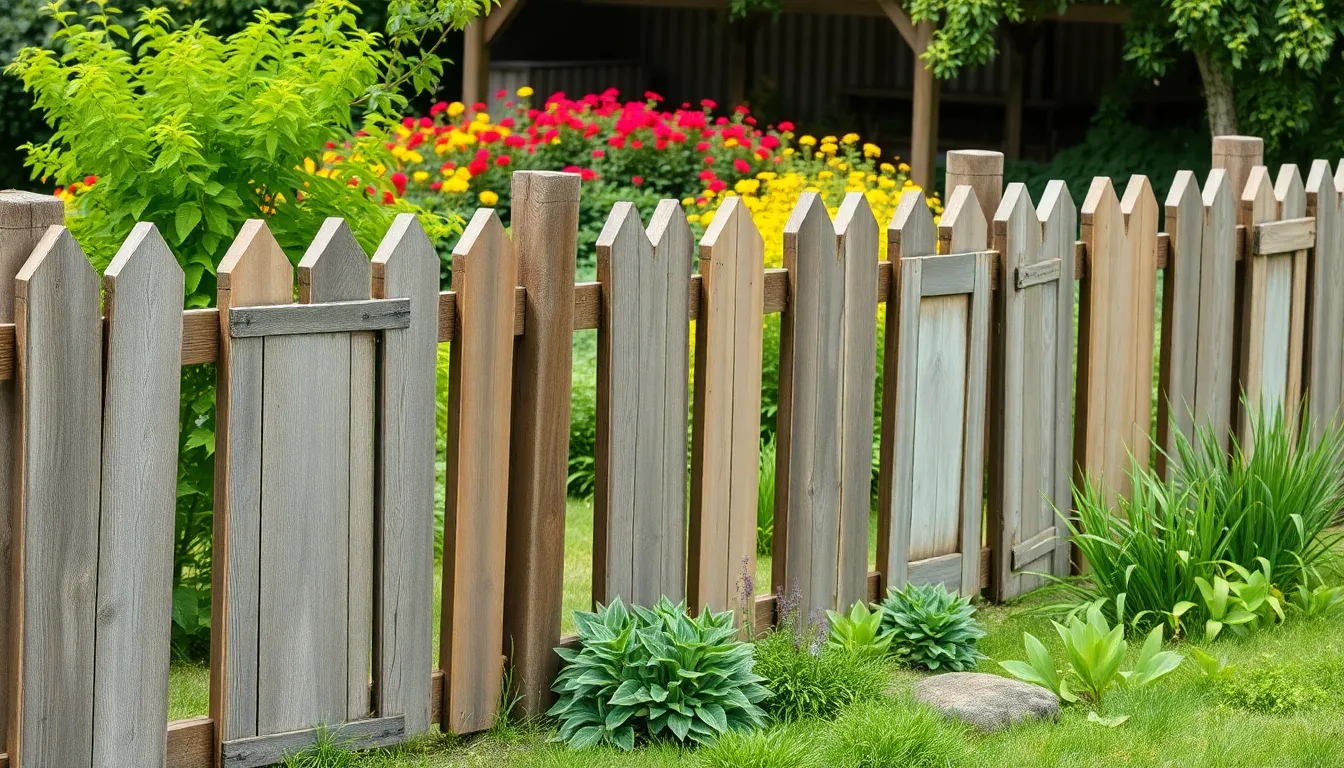
We’ll explore innovative ways to transform discarded materials into attractive garden boundaries that cost significantly less than traditional fencing options.
Repurposing Old Doors and Windows
Upcycled door fencing creates stunning vintage garden boundaries by attaching salvaged doors to wooden posts. We recommend sourcing doors from home renovation projects, salvage yards, or demolition sites where prices typically range from $10-30 per door. Old barn doors, French doors, and panel doors work exceptionally well for this application.
Installation requires basic carpentry skills and standard tools like a drill, level, and measuring tape. We secure each door to 4×4 treated posts using heavy duty hinges or metal brackets, ensuring the posts extend at least 2 feet into the ground for stability. The total project cost averages $40-60 per 8 foot section when using reclaimed materials.
Window panel fencing transforms discarded windows into decorative garden screens that allow natural light while providing partial privacy. We hang old windows between posts using chain or cable systems, creating an airy barrier perfect for separating garden sections. Single pane windows work best since they’re lighter and easier to manage during installation.
Creative arrangements include mixing different window sizes for visual interest or grouping similar frames for a cohesive look. We often combine window panels with climbing plants like morning glories or clematis to create living fence combinations that enhance the vintage aesthetic.
Using Corrugated Metal Sheets
Corrugated metal fencing provides durable and modern garden boundaries at significantly lower costs than traditional materials. We source metal sheets from roofing suppliers, farm supply stores, or metal recycling facilities where prices range from $15-25 per 8 foot panel.
Installation involves attaching sheets to wooden or metal posts using self drilling screws designed for metal applications. We recommend galvanized or aluminum corrugated panels since they resist rust and weathering better than standard steel options. Each 8 foot section typically requires 12-16 screws for proper securing.
Design flexibility allows us to install panels vertically for privacy or horizontally for a contemporary industrial look. We often combine different metal finishes like weathered steel with galvanized panels to create visual contrast. The total material cost averages $30-45 per linear foot including posts and hardware.
Maintenance benefits include easy cleaning with soap and water, excellent weather resistance, and the ability to paint or powder coat for color customization. We’ve found that properly installed corrugated metal fencing can last 15-20 years with minimal upkeep requirements.
Living Fence Ideas Using Plants and Shrubs

Nature provides some of the most affordable garden fencing answers that grow more beautiful over time. Living fences offer privacy, attract wildlife, and create stunning boundaries without the ongoing maintenance costs of traditional materials.
Fast-Growing Hedge Options
Privet hedges establish quickly and form dense barriers within two growing seasons. We recommend planting privet shrubs 18-24 inches apart for complete coverage, as this fast growing species can reach 6-8 feet in just three years. Maintenance requires only annual pruning to maintain shape and density.
Yew bushes create durable evergreen boundaries that withstand harsh weather conditions. These hardy plants grow 12-18 inches annually and respond well to regular trimming, making them ideal for formal hedge designs. Yew hedges can last decades with minimal care beyond seasonal shaping.
Cypress trees provide rapid vertical growth and natural wind protection for garden spaces. We’ve found that Leyland cypress varieties can grow 3-4 feet per year, creating substantial barriers quickly. Regular pruning keeps cypress hedges manageable while promoting fuller, denser growth patterns.
Climbing Vine Fence Alternatives
Clematis vines produce stunning flowers while covering existing structures or simple wire supports. We suggest installing basic trellis systems costing under $20 to support clematis growth, as these climbing plants can reach 8-12 feet in a single season. Popular varieties like Sweet Autumn clematis bloom prolifically and require minimal maintenance.
Honeysuckle creates fragrant barriers that attract beneficial pollinators to garden areas. Fast growing honeysuckle varieties can cover 200 square feet of fencing within two years, though frequent pruning prevents aggressive spreading. We recommend native honeysuckle species to avoid invasive growth patterns.
Grapevines offer dual purpose fencing that provides fruit harvests alongside privacy screening. Training grapevines on simple wire systems costs approximately $15-25 per 20 foot section, creating productive boundaries. Annual pruning maintains vine health while encouraging both grape production and dense foliage coverage.
Temporary Fencing Solutions for Renters
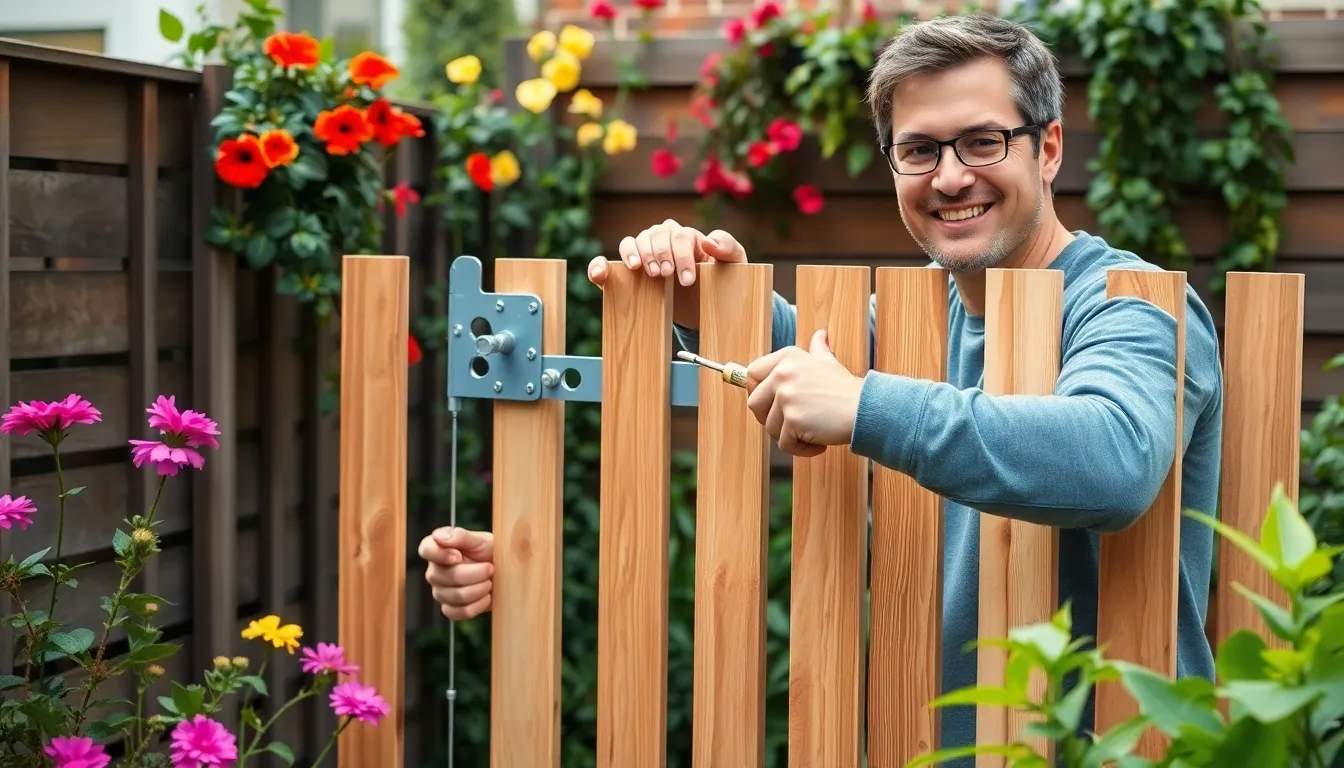
Renters need garden boundaries that won’t violate lease agreements or damage property. Mesh garden netting with wooden or metal stakes creates effective barriers at minimal cost, typically under $30 for a small garden perimeter.
Portable Panel Systems
Portable panel systems offer maximum flexibility for temporary garden boundaries. Lightweight panels made from wood, plastic, or metal connect quickly using brackets or hooks without requiring any tools for assembly. Home improvement stores stock these versatile systems, with prices ranging from $25 to $45 per panel depending on material and size.
Steel mesh panels with ground spikes provide exceptional stability while maintaining portability. Connection points allow panels to link together seamlessly, creating continuous barriers that adapt to various garden shapes. Reconfiguration takes minutes rather than hours, making seasonal boundary changes effortless for renters who want to modify their outdoor spaces.
Most systems feature interlocking mechanisms that ensure panels stay aligned during wind or weather events. Moving day becomes stress free since panels disconnect easily and stack flat for transport. Storage requirements remain minimal due to the compact design of most portable fencing systems.
No-Dig Installation Methods
No dig installation eliminates the need for concrete footings or permanent post holes. Ground spikes, anchor plates, and weighted bases secure fencing without disturbing soil or violating rental agreements. Metal stakes with screw in ground anchors provide firm foundations for mesh or wood panels in most soil types.
Weighted pot systems work exceptionally well for free standing trellises and wire fencing installations. Sandbags offer another stability solution that requires zero ground penetration while providing adequate support for lightweight barriers. These methods typically cost 40% less than traditional concrete installations while taking half the setup time.
Anchor plate systems distribute weight across larger surface areas, preventing panels from tipping during storms. Installation typically requires only basic hand tools like screwdrivers and rubber mallets. Removal leaves no trace of fencing presence, protecting security deposits and maintaining positive landlord relationships.
| Installation Method | Average Cost | Setup Time | Soil Impact |
|---|---|---|---|
| Ground Spikes | $15-25 | 30 minutes | Minimal holes |
| Weighted Bases | $20-35 | 45 minutes | None |
| Anchor Plates | $25-40 | 60 minutes | Surface only |
Hardware Store Budget Fencing Materials
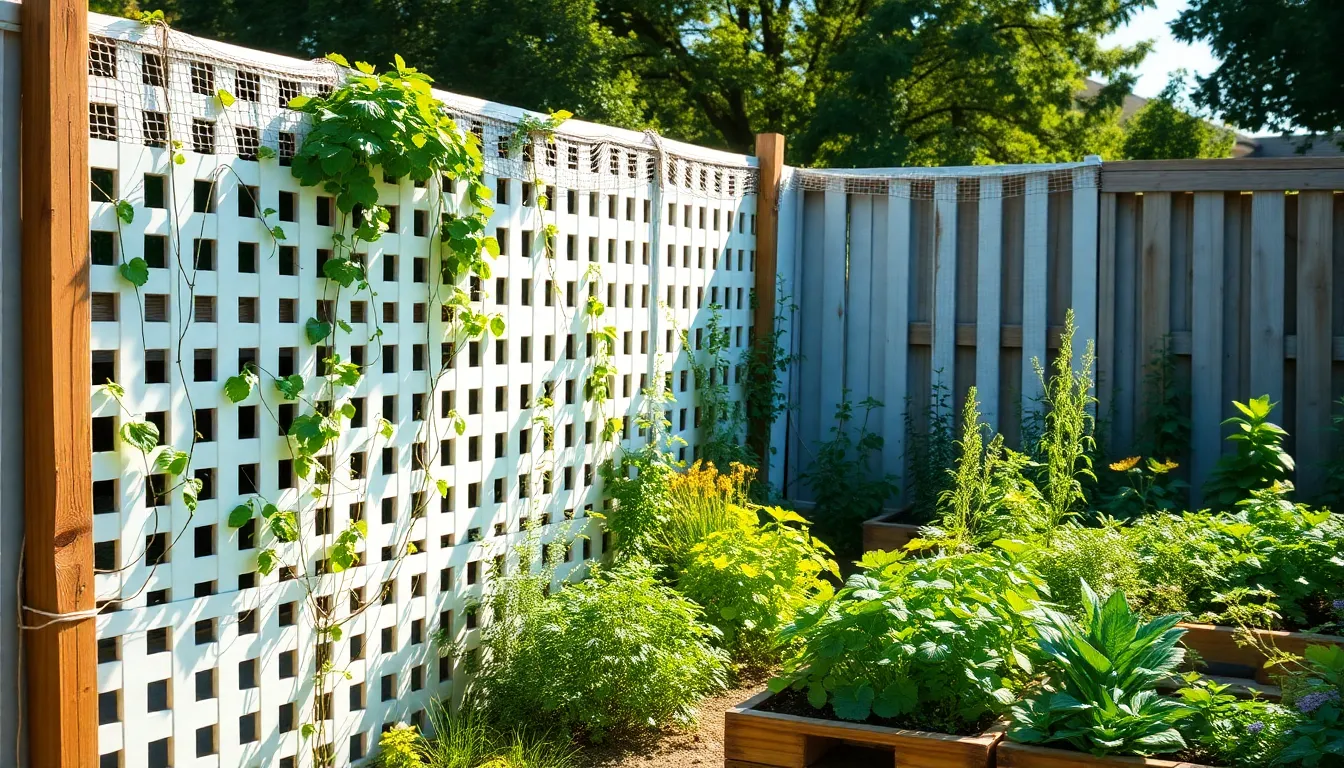
Hardware stores offer some of the most affordable fencing answers that we can assemble ourselves. These budget-friendly materials deliver function without compromising our garden’s appearance.
Vinyl Lattice Panel Options
Vinyl lattice panels provide an excellent middle ground between basic netting and expensive solid fencing options. These interlocking panels typically cost between $25-40 each at major hardware retailers and create attractive decorative barriers with moderate privacy.
Installation requires minimal tools since most panels connect through simple bracket systems. We can easily cut these panels to fit irregular spaces using basic saws, making them perfect for corner gardens or oddly shaped yards. The weather-resistant material withstands harsh conditions without rotting or warping like traditional wood lattice.
Most hardware stores stock standard 2×8 foot and 4×8 foot panel sizes that work well for garden borders. We’ve found these panels particularly useful for creating partial privacy screens around patios or separating different garden sections. The diamond or square lattice patterns allow climbing plants to grow through them, creating living walls over time.
Chain Link Alternatives Under $100
Traditional chain link fencing often exceeds $100 per section, but we can achieve similar functionality using creative alternatives from hardware store materials. Plastic garden netting stapled to wooden stakes mimics chain link’s openness while costing under $50 for a 10×8 foot area.
Untreated lumber cut into slats and nailed to vertical posts creates sturdy boundaries for less than $75 per 20-foot section. We source 1×4 inch boards and 4×4 inch posts from discount lumber sections to keep costs minimal. This DIY approach lets us customize spacing between slats based on our exact needs.
Repurposed shipping pallets offer another chain link alternative that costs nothing beyond our time and effort. We disassemble pallets carefully and reassemble the boards into modular fence sections. These rustic barriers work especially well for vegetable gardens where we need to keep animals out without blocking airflow.
Wire mesh panels stretched between metal T-posts provide the most chain link-like appearance at budget prices. A 50-foot roll of welded wire mesh costs around $35-45, and metal posts run about $8-12 each. This combination creates secure boundaries that contain pets and define property lines effectively.
DIY Post Installation to Save on Labor Costs
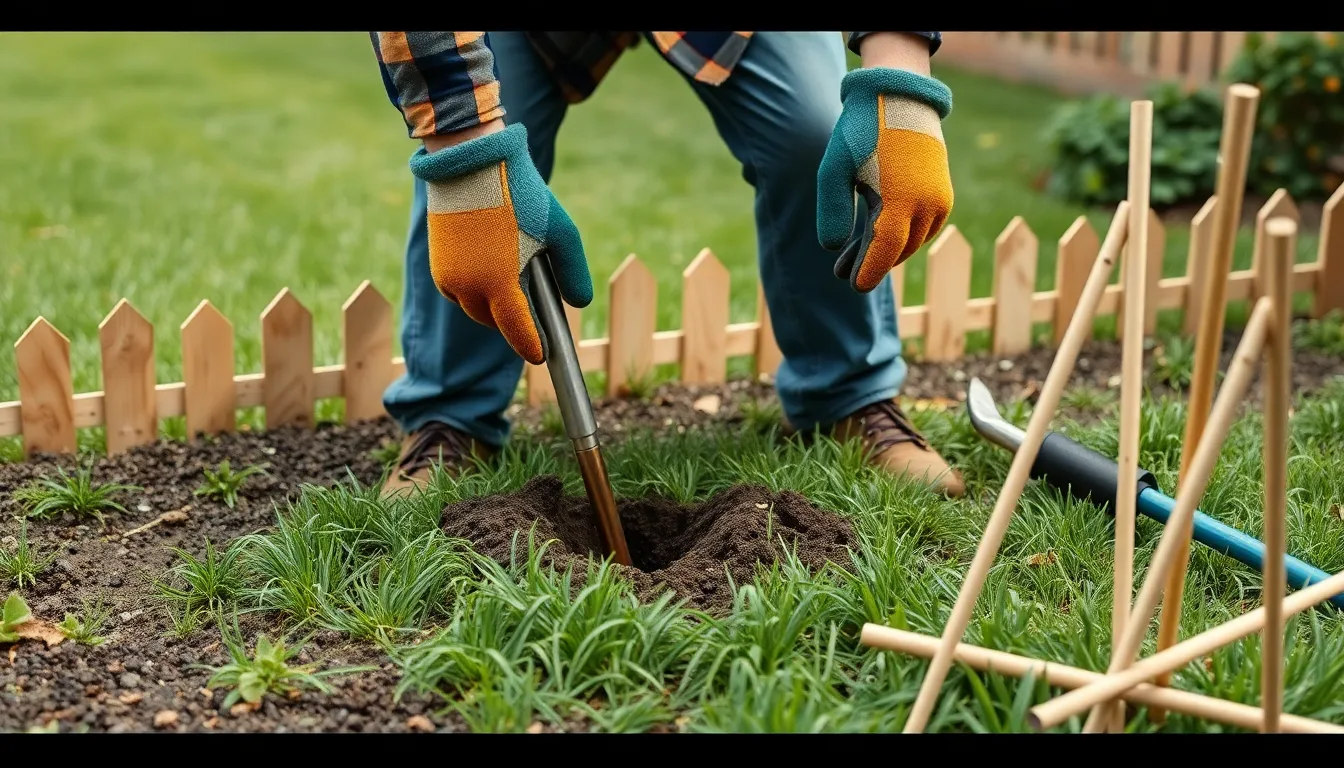
Installing fence posts yourself represents one of the biggest opportunities to cut costs on any garden fencing project. Professional installation typically adds 40-60% to total project expenses, making DIY post setting a worthwhile skill to master.
Setting Posts Without Professional Help
Mark your fence perimeter first and measure lengths accurately before beginning any digging. We recommend spacing posts 6-8 feet apart for optimal stability and material efficiency.
Drive wooden stakes directly into soil for lightweight fencing projects like plastic netting installations. This method works perfectly for garden bed borders and temporary boundaries without requiring concrete or deep excavation.
Dig holes approximately 2 feet deep for heavier fence materials using a post hole digger or manual shovel. Position 4×4 treated lumber posts in these holes and surround them with concrete for maximum stability.
Pour concrete around posts using standard bags from hardware stores, which cost around $3-5 each and provide long-lasting support. We’ve found that one bag typically secures one standard fence post when mixed properly.
Level posts vertically using a bubble level to ensure consistent fence height and professional appearance. This step prevents sagging and maintains structural integrity over time.
Build fence sections in place by stapling material directly to installed posts rather than pre-assembling panels. This approach reduces handling difficulties and ensures tighter material attachment.
Tools and Techniques for Beginners
Gather essential tools before starting including a staple gun, hammer, screwdrivers, measuring tape, level, and post hole digger. Most homeowners already own these basic implements or can borrow them from neighbors.
Use a staple gun as your primary attachment method for securing plastic netting, chicken wire, or fabric materials to wooden posts. We recommend heavy-duty staplers that can penetrate treated lumber effectively.
Employ basic carpentry tools like drills, screws, and hinges when constructing gates or wooden frame sections. These same tools work for repurposing pallet wood into custom fence panels.
Measure twice and cut once to avoid material waste and ensure accurate fitting. We suggest marking all measurements clearly before making any cuts to lumber or fencing materials.
Build in manageable 5-6 foot sections to keep materials taut and reduce installation stress. This technique prevents sagging and makes the entire project more accessible for beginners.
Follow step-by-step tutorials and use online guides to complete projects successfully while avoiding common mistakes. We’ve found that visual references help novice builders achieve professional-looking results without prior experience.
Creative Combination Fencing Ideas
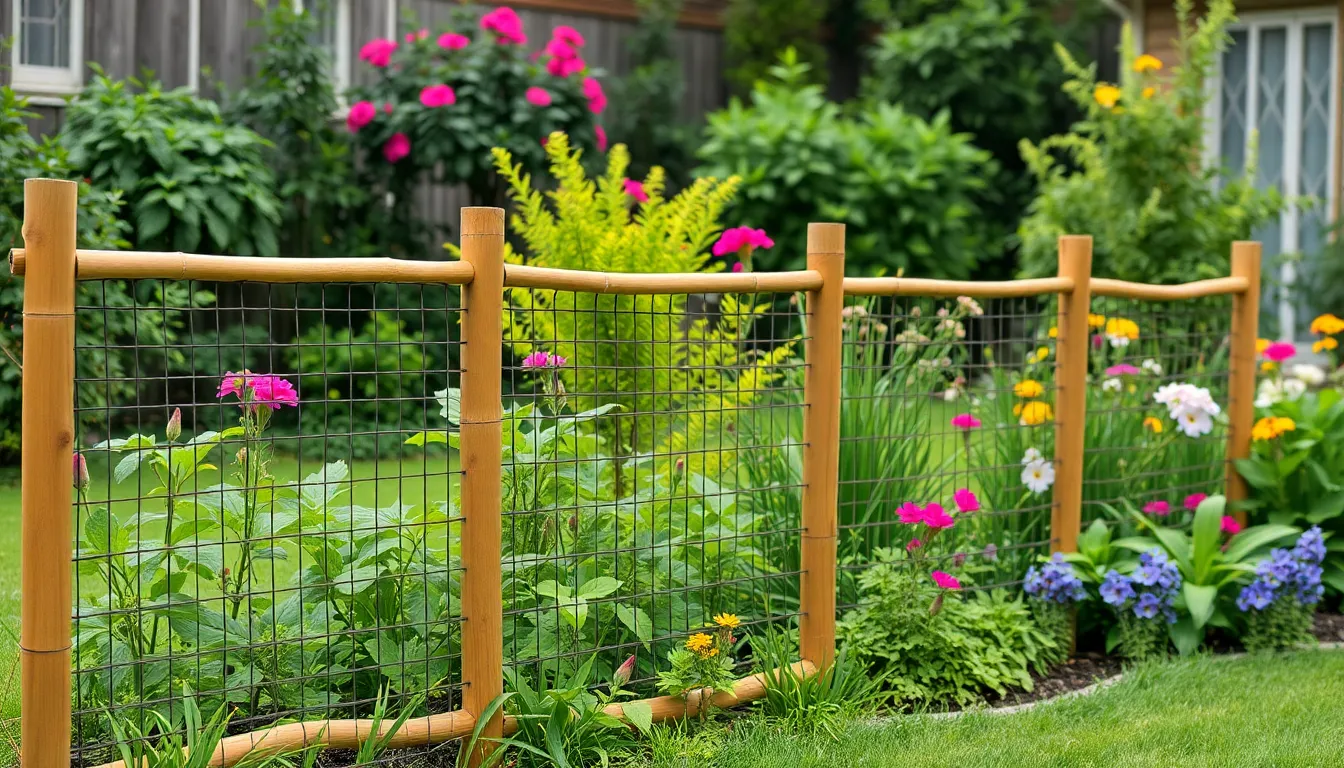
Combining different materials and techniques transforms ordinary garden boundaries into visually striking features that maximize both function and style. These creative approaches allow us to achieve professional-looking results while keeping costs well below traditional fencing options.
Mixing Materials for Unique Looks
Wood and wire combinations create rustic charm while delivering exceptional value for your garden fencing project. We recommend using wooden posts as the foundation, then stretching wire mesh between them to form an attractive barrier that costs significantly less than solid wood panels. This approach works particularly well for vegetable gardens where you need pest protection without blocking airflow.
Plastic and bamboo pairings offer lightweight installation with natural aesthetic appeal. Bamboo sticks provide vertical structure while plastic netting fills the gaps, creating an inexpensive fence that’s perfect for temporary boundaries or rental properties. The total cost typically runs under $40 for a 20-foot section, making it one of our most budget-friendly recommendations.
Recycled material integration transforms discarded items into functional garden features. Old pallets serve as panel bases, while salvaged wire mesh or wooden slats fill openings to create unique textures and patterns. We’ve seen gardeners combine everything from old doors with chicken wire to create stunning vintage-inspired boundaries that cost virtually nothing beyond your time and creativity.
Layering Different Fence Types
Height variation techniques add visual interest by combining shorter fences in front with taller ones behind. This approach creates depth and dimension while allowing you to use different materials at various levels. We often suggest placing decorative low bamboo edging in front of practical wire mesh fencing to achieve both beauty and function.
Texture mixing strategies pair smooth materials with rough ones for compelling visual contrast. Combining smooth wood planks with rough stone bases or mixing metal wire mesh with natural branch weaving creates professional-looking results. These combinations work exceptionally well when you want to match existing industry features while maintaining budget constraints.
Layered material stacking involves building up different fence types to create complex, multi-dimensional boundaries. Start with a basic wire mesh foundation, then add wooden slats at intervals, and finish with climbing plants or decorative elements. This technique allows you to spread costs over time while building increasingly sophisticated garden borders that evolve with your landscaping needs.
Conclusion
Creating an attractive garden fence doesn’t have to drain your wallet. We’ve shown you that with creativity and smart material choices you can build stunning boundaries for under $50 in most cases.
Whether you choose bamboo panels for quick installation or jump into a pallet wood project for weekend fun these budget-friendly options prove that style and functionality go hand in hand. The key is matching your fencing choice to your exact needs and skill level.
Remember that the best cheap garden fence is one that serves your garden’s purpose while reflecting your personal style. With these ideas in your toolkit you’re ready to transform your outdoor space without very costly.
Frequently Asked Questions
What are the most affordable garden fencing options under $50?
The most budget-friendly options include chicken wire fencing (around $16.44 per roll), repurposed pallet wood (often free), bamboo rolled fencing ($1-3 per linear foot), and natural branch/twig fencing using collected materials. These options can effectively fence small to medium garden areas while maintaining functionality and visual appeal.
How much does bamboo fencing cost compared to traditional wood?
Bamboo fencing typically costs 40-60% less than traditional wood fencing. Ready-made bamboo panels range from $25-45 each, while rolled bamboo fencing costs $1-3 per linear foot. Custom bamboo pole fencing can be created for under $30 per 20-foot section, making it an excellent budget-friendly alternative.
Can I create garden fencing using free materials?
Yes, pallet wood fencing is often completely free, requiring only time and effort to repurpose shipping pallets. You can source pallets from shipping companies, furniture stores, and construction sites. Natural branch and twig fencing also uses collected fallen branches, making it virtually cost-free while creating charming, eco-friendly boundaries.
What’s the easiest DIY fencing option for beginners?
Chicken wire fencing is the easiest for beginners, requiring minimal tools and basic DIY skills. Installation is straightforward with lightweight construction, and total project costs rarely exceed $30 for smaller boundaries. The process involves simple post installation and wire attachment, making it perfect for first-time fence builders.
Are there temporary fencing solutions for renters?
Yes, several renter-friendly options exist including mesh garden netting with stakes, portable panel systems, and no-dig installation methods using ground spikes or weighted bases. These solutions provide security and privacy without violating lease agreements or damaging property, and can be easily removed when moving.
How can I combine different materials for unique fencing designs?
Creative combinations include mixing wood and wire for rustic charm, using plastic and bamboo for lightweight installations, and integrating recycled materials for unique designs. You can layer different fence types, mix textures, and combine various heights to create visually striking, multi-dimensional boundaries that enhance your garden’s aesthetic appeal.
What tools do I need for DIY fence installation?
Essential tools include a post-hole digger or shovel, level, measuring tape, drill with bits, wire cutters, and basic hand tools. For concrete installation, you’ll need a mixing container and trowel. Most budget fencing projects require only common household tools, keeping additional equipment costs minimal.
How long do budget fencing materials typically last?
Durability varies by material: treated bamboo can last 5-10 years, pallet wood 3-7 years depending on treatment, chicken wire 5-8 years, and natural branch fencing 2-4 years. Proper treatment, regular maintenance, and protective finishes can significantly extend the lifespan of most budget-friendly materials.







